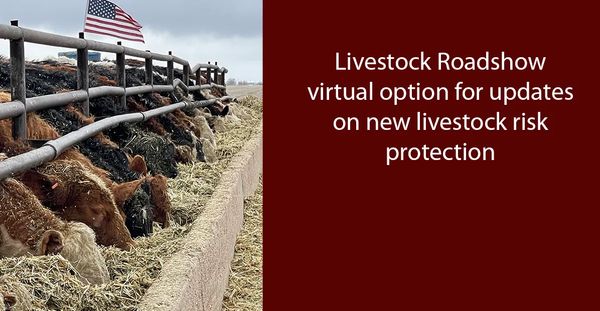Proactive Protection: Bagley Risk Management Tips
Proactive Protection: Bagley Risk Management Tips
Blog Article
Recognizing Livestock Danger Defense (LRP) Insurance Policy: A Comprehensive Guide
Navigating the realm of livestock danger protection (LRP) insurance can be a complex endeavor for many in the farming industry. From exactly how LRP insurance coverage functions to the various protection alternatives readily available, there is much to uncover in this extensive guide that can potentially form the method animals producers approach risk management in their companies.

How LRP Insurance Works
Occasionally, comprehending the auto mechanics of Animals Risk Security (LRP) insurance coverage can be intricate, but breaking down how it works can give clarity for farmers and breeders. LRP insurance policy is a risk management tool made to protect animals manufacturers versus unanticipated price declines. It's crucial to note that LRP insurance policy is not an income assurance; instead, it focuses exclusively on rate danger security.
Eligibility and Protection Options
.png)
When it concerns coverage options, LRP insurance supplies manufacturers the flexibility to select the insurance coverage degree, coverage period, and endorsements that best match their threat monitoring requirements. Protection levels generally range from 70% to 100% of the anticipated ending value of the insured animals. Producers can also pick coverage periods that align with their manufacturing cycle, whether they are insuring feeder cattle, fed cattle, swine, or lamb. Endorsements such as cost danger security can additionally tailor coverage to protect against negative market variations. By recognizing the qualification standards and coverage options readily available, animals producers can make educated decisions to handle danger properly.
Advantages And Disadvantages of LRP Insurance
When evaluating Animals Risk Security (LRP) insurance, it is important for livestock producers to consider the benefits and drawbacks intrinsic in this danger management device.

Among the key benefits of LRP insurance is its capability to provide defense against a decline in animals rates. This can help guard producers from monetary losses arising from market fluctuations. In addition, LRP insurance coverage supplies a level of adaptability, allowing producers to customize insurance coverage levels and plan durations to suit their particular requirements. By securing in an ensured cost for their animals, manufacturers can much better manage risk and prepare for the future.
One constraint of LRP insurance coverage is that it does not protect versus all kinds of threats, such as illness outbreaks or all-natural disasters. It is important for producers to very carefully assess their individual risk exposure and economic circumstance to figure out if LRP insurance is the best threat administration device for their procedure.
Comprehending LRP Insurance Premiums

Tips for Optimizing LRP Benefits
Making the most of the benefits of Animals Danger Protection (LRP) insurance policy needs critical preparation and positive risk administration - Bagley Risk Management. To make the many of your LRP insurance coverage, think about the following suggestions:
Regularly Analyze Market Conditions: Stay informed about market fads and price changes in the livestock sector. By keeping an eye on these factors, you can make educated choices regarding when to buy LRP protection to protect against potential losses.
Establish Realistic Coverage Levels: When picking insurance coverage levels, consider your production costs, market price of livestock, and possible threats - Bagley Risk Management. Establishing sensible coverage levels ensures that you are appropriately shielded without paying too much for unneeded insurance coverage
Diversify Your Coverage: As opposed to counting solely on LRP insurance coverage, take into consideration expanding your danger management strategies. Incorporating LRP with various other danger administration tools such as futures agreements or alternatives can provide thorough insurance coverage against market unpredictabilities.
Evaluation and Adjust Insurance Coverage Frequently: As market problems transform, regularly review your LRP insurance coverage to ensure it straightens with your present threat direct exposure. Adjusting protection levels and timing of purchases can aid enhance your threat security technique. By adhering to these suggestions, you can maximize the benefits of LRP insurance and secure your animals procedure against unpredicted risks.
Verdict
In conclusion, livestock danger defense (LRP) insurance is a useful device for farmers to manage the economic risks related to their animals operations. By recognizing how LRP functions, eligibility and insurance coverage choices, along with the pros and cons of this insurance policy, farmers can make educated choices to shield their livelihoods. By meticulously considering LRP premiums and executing strategies to maximize benefits, farmers can reduce potential losses and guarantee the sustainability of their procedures.
Animals manufacturers interested in obtaining Livestock Threat Protection (LRP) insurance policy can explore a range of eligibility standards and coverage alternatives tailored to their specific livestock procedures.When it comes to coverage options, LRP insurance provides producers the flexibility to select the insurance coverage degree, protection period, and recommendations that best fit their danger monitoring demands.To grasp the intricacies of Livestock Threat Defense (LRP) insurance totally, understanding the factors affecting LRP insurance premiums is essential. LRP insurance costs are determined click to investigate by numerous aspects, including the insurance coverage degree selected, the expected cost of livestock at the end of the insurance coverage duration, the kind of animals being insured, and the size of the protection period.Review and Adjust Protection On a regular basis: As market problems change, occasionally examine your LRP coverage to guarantee it aligns with your existing threat direct exposure.
Report this page